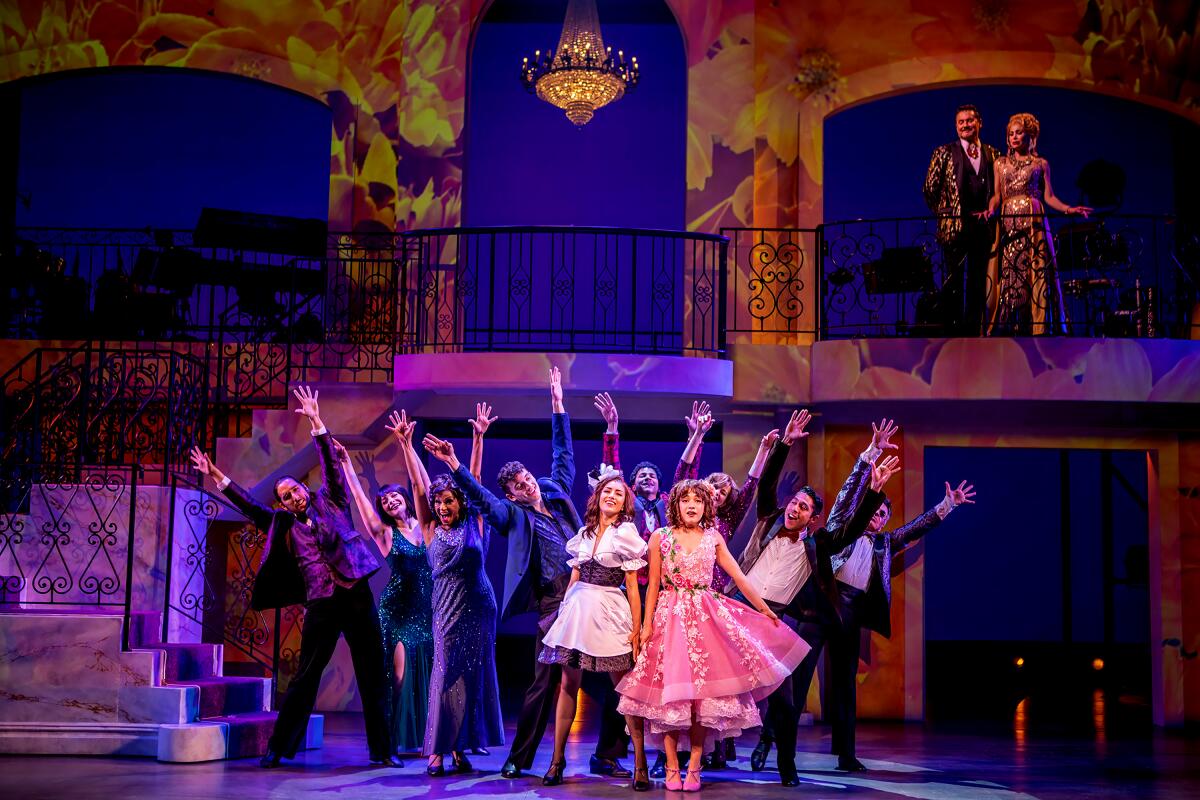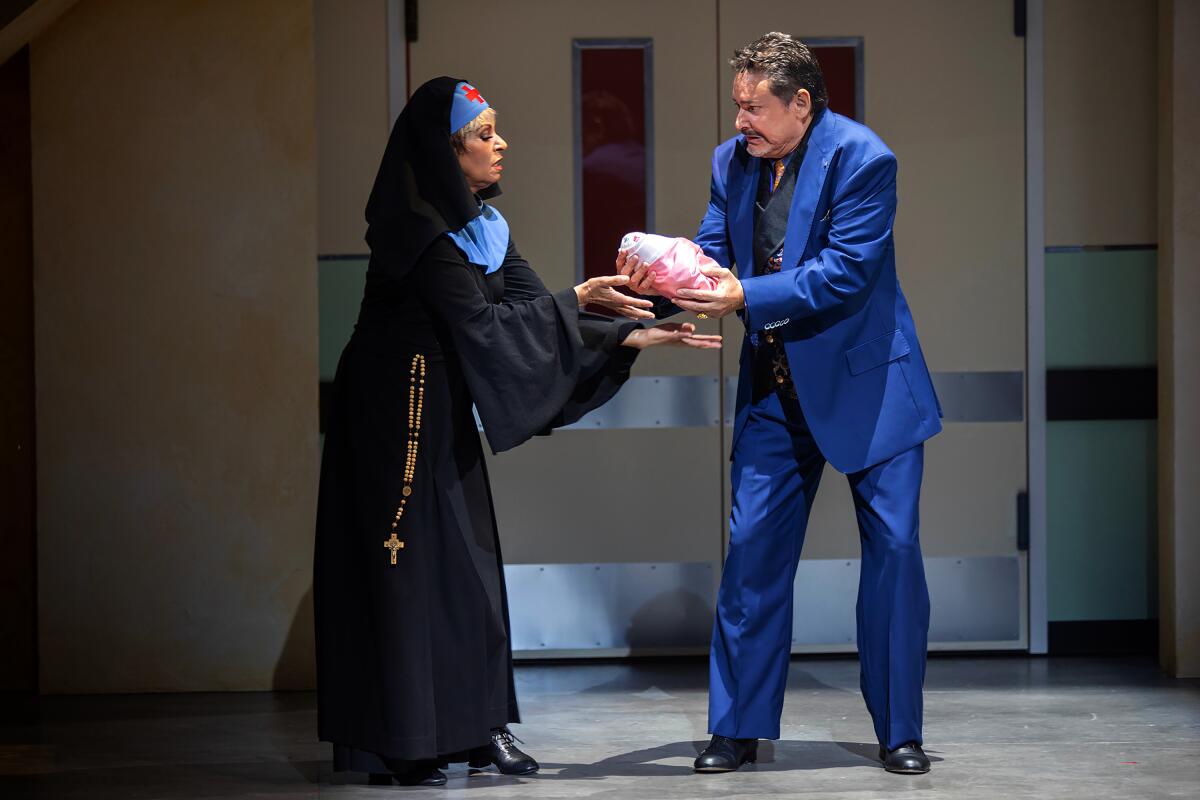How an act of defiance became a rapturous musical celebrating Latino representation

- Share via
Telenovelas often get a bad rap.
Some who are unfamiliar with the culture and artistry of telenovelas tend to look down on the art form, seeing each overt reaction and prolonged dramatic pause on screen as tacky. But when that stereotype gets confused for the truth, Latino art is hurt the most.
While Karen Zacarías discussed this with compatriots in the national Latinx Theatre Commons, she shared how frustrating it is to hear critics intentionally, and derisively, write off disparate forms of Latino art as “telenovelas.”
“I decided to write the best telenovela I could for the stage so that no other plays would be compared to that,” Zacarías says.
That act of defiance soon evolved into an act of joy as she created what would become “Destiny of Desire.” The telenovela-inspired musical follows two babies switched at birth. One enters a life of wealth, the other, poverty. As time passes, a series of emotional familial discoveries — from affairs to death — expose complex characters and bring the audience in.

“Destiny of Desire” made its world premiere at the Arena Stage in Washington, D.C., in 2015 and has a new production at the Old Globe in San Diego running until June 25. (The show had a previous production in Southern California at South Coast Repertory in 2016.)
In Zacarías’ research of melodrama, she soon realized the mechanics of the telenovela are not as foreign as ignorant critics or viewers make it out to be. Telenovelas are “part of our cultural landscape,” she says.
The art form is filled with heightened drama. Bringing the sensation of a telenovela to the stage was achieved not only with theatrical conventions, but also by showing the audience that these dramatic moments are “not as outlandish as what is going on in the real world,” Zacarías says.
Throughout “Destiny of Desire,” Zacarías contextualizes events to show that they aren’t as far-fetched as they might seem. For example, in the middle of a mother-daughter argument, an actor pops up as a narrator to share that “60% of daughters describe their relationship with their mothers as ‘strained … and dysfunctional.’”
Zacarías also includes statistics regarding identity, gun violence and gender.
“The thing with the telenovela is it’s so rooted in truth,” says actress Mandy Gonzalez, who plays Hortencia del Rio, a financially strapped mother who works for a wealthy woman. “It’s just the truth is a little bit heightened because of the situations that you’re put into, but the acting in the telenovela is genius.”

The performers work with director Ruben Santiago-Hudson to bring out the emotional core of these characters. There is truth in the “absurd realities,” he says.
Bianca Marroquín, who plays Fabiola Castillo, a beauty queen married to the richest man in town, says: “I myself try to make my character very human so they can understand why Fabiola became a villain, and why she is this way — why she is bitter and why she learned to be ruthless.”
After setting up the characters as simply bad or good, “Destiny of Desire” slowly starts to tear away preconceived notions of who these people are and reveals their complexities. There is a reason for their arc, and in Fabiola’s case, Marroquín says she is hurt by what society pushed her to become.
This is exactly what telenovelas do.
“No one is bad for the sake of being bad,” Zacarías says. “It depends on their level of desperation.”

Respect for the genre comes from within the production, as many artists involved either watched telenovelas growing up or have been part of one themselves. Santiago-Hudson has been in American melodramas such as “Another World” and “All My Children.”
“I learned to respect this thing that people will laugh at,” Santiago-Hudson says.
The role of Hortencia del Rio attracted Gonzalez because she grew up with her abuelita, her grandmother, watching telenovelas in the living room. She recalls her abuelita gasping at each twist and turn on the screen.
Zacarías is delighted by the gasps and audible “oh nos” from the audience. She explains that it’s achieved by a “tightrope” wherein performers stay in the story’s dramatic reality.
Marroquín mastered the tightrope while working on “Esperanza del corazón” as a lead actress. She joined the telenovela in 2011 and quickly learned the importance of timing, rhythm and pauses. She’d be asked to stay in emotions like anger or shock for up to a minute, while the cameras caught reactions.

“The music is on, giving you the drama of it, pointing out what emotion the audience is supposed to be having at that time,” Marroquín says. “At that point — if it’s dangerous, if it’s sad, if it’s excitement — you have to hold that emotion and let the cameras do their job.”
Santiago-Hudson was familiar with these conventions, which push actors to stay in heightened emotions and give everything no matter what part of the process the performers are in — whether it was the first rehearsal or tech. Marroquín says it was preparation for the final product, exercising the emotional muscles of the characters.
Zacarías points out that while people tend to laugh at the melodramatic genre, it’s a big part of our culture and also informs K-drama and Bollywood. She even adds a statistic on viewership in the play, sharing that “the telenovela is the number one form of entertainment in the world today.”

Why is it so popular? Its conventions pull from theater history. Historical playwrights like William Shakespeare and Molière incorporate melodramatic storytelling, from big reveals to dramatic antics — as in “Tartuffe,” when one of the characters hides under the table and learns the truth about Tartuffe’s advances on his wife.
Zacarías pays homage to this theatrical history in “Destiny of Desire” while also questioning why telenovelas are not part of this same esteemed lineage. Her work asks: What makes telenovelas exempt from similar praise?
The answer points back to where the play started: critics comparing Latino storytelling to telenovelas in a “disparaging” way, which in turn limits the representation of Latinos we see on stage and screen.
Every year, a new report shares the lack of Latino representation in film and TV. The latest comes from the Latino Donor Collaborative’s “2022 LDC Latinos in Media Report,” which shares that although Latinos make up nearly 20% of the U.S. population, only 3.1% of lead television actors and 5.2% of lead film actors are Latino or Hispanic. This statistic is particularly striking when we look at L.A., the home of Hollywood, where almost half of the population is Latino, according to the U.S. Census.
Santiago-Hudson says that “Destiny of Desire” allows the artists of color who are part of the production to shine beyond the one-dimensional characters the industry has imposed on them, and more specifically, by the skewed public perception of telenovelas.
“What I want to make sure that [what] penetrates the people who come into this audience is the completeness and wholeness of brown and Black people, as human beings,” he says.
'Destiny of Desire'
Where: Old Globe Theatre, 1363 Old Globe Way, San Diego
When: 2 and 7 p.m. Wednesday, 8 p.m. Thursday and Friday, 2 and 8 p.m. Saturday, 2 and 7 p.m. Sunday. Ends Sunday.
Tickets: $33-$125
Info: theoldglobe.org, (619) 234-5623
More to Read
The biggest entertainment stories
Get our big stories about Hollywood, film, television, music, arts, culture and more right in your inbox as soon as they publish.
You may occasionally receive promotional content from the Los Angeles Times.











